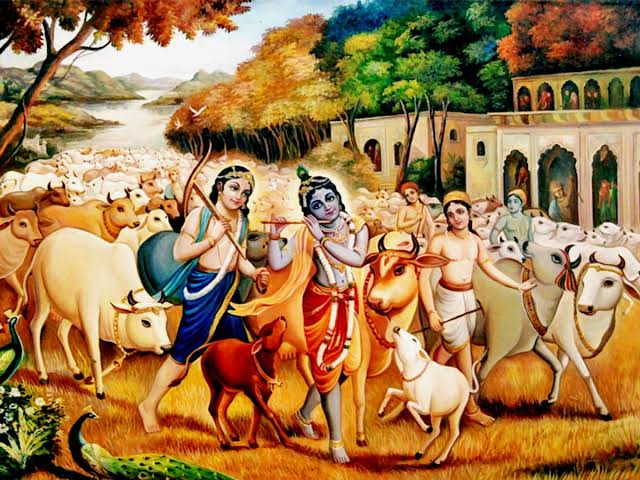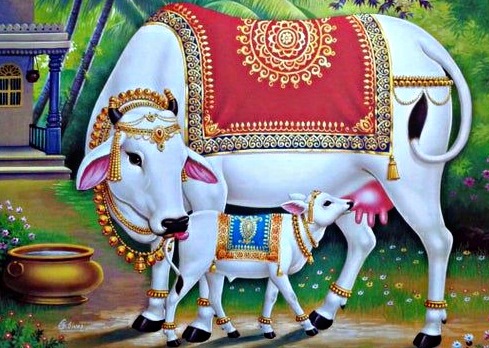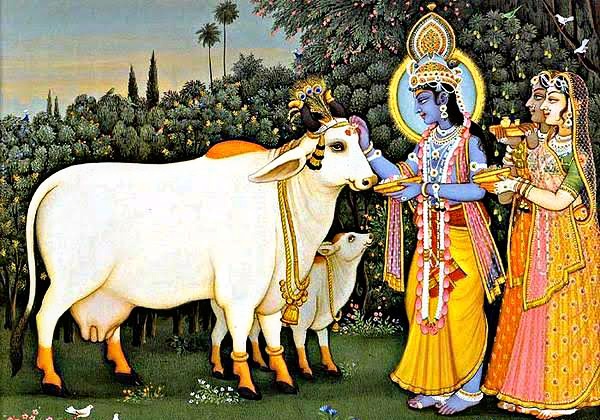Hindus strongly believes in nature & worship it. The base of Hinduism is strongly connected to the Mother Nature. During the Vedic period, Hindus used to live with the help of nature, connected to its roots & protecting it. At that time cows (गौः) supported the human settlement. They grazed & provided milk; their progeny was utilized by humans for farming. Cow dung was used as plaster & a binding agent for building huts while the dried cow dung cakes were used as fuel. Cow dung was also used as a fertilizer for farming. Further; clarified butter, buttermilk, curd, etc. are derivates of milk, which are used for religious austerities also. And if a person had a cow (गौः), he was considered to be rich, cultured & fortunate. In today’s era too, Hindus still believe the same & worship cows as a Goddess.
There is a day on which a big celebration is done where all the cows are worshipped. It is the festival of Gopashtami (गोपाष्टमी). It is celebrated every year on the eighth day of bright fortnight of Kartika month (कार्तिकः शुक्लपक्षस्य अष्टमी (०८)). It is considered as one of the most important festival in Hinduism. According to the Hindu Scriptures, Gods & Goddesses dwells in a cow (गौः) & as she provides humans basic needs, Hindus consider cows as a mother & worship it. According to the Puranas, serving a cow (गौः) & worshipping it, one gets the blessings of happy & prosperous life.

Historical account of Gopashtami (गोपाष्टमी) –
According to the Puranas, the first historical account is the day Nanda Maharaja sent his children Krishna & Balarama to herd the cows for the first time. Only when boys stepped into the age of 6 years, they can get the charge of herding the cows. As Balarama & Krishna stepped into the age of 6 years, King Nanda consults a Brahmin Priest & after a pooja ritual both the brothers were eligible of herding cows. After the ritual Lord Krishna & Lord Balarama started herding cows. As this ritual held on the eighth day of bright fortnight of the Kartika month (कार्तिकः शुक्लपक्षस्य अष्टमी (०८)), this day is celebrated as Gopashtami (गोपाष्टमी) in Hinduism. Since this day Lord Krishna is also known as Gopala (गोपलः) (i.e., A cowherd/ the one who protects the cows) & Govinda (गोविन्दः) (i.e., A cowherd/ the one who controls or protects the cows).
According to another legend, Lord Krishna convinced the people of Gokul to not make abundant offerings to Lord Indra. He taught the farmers & cowherds, that their true Dharma (Duty) (धर्मः) is towards the hills & cattle which gave them supplies & resources. The people then started praying Govardhan Hill & the cows. Knowing this, Lord Indra got furious & discarded his anger upon the people of Gokul. He started flooding Gokul with nonstop rains which continued for seven days & seven nights. Following this, Lord Krishna lifted the Govardhan mountain with his little finger to provide shelter & protection to the people & the cattle. Indra then realized his mistake & apologized on the eighth day of the bright fortnight of Kartika month. Thus, this day is celebrated as Gopashtami (गोपाष्टमी) by these two historical accounts. This both stories at the end suggests the importance of cows in human life & so this day is named after cow itself.

Significance of Gopashtami (गोपाष्टमी) –
In Hinduism, the cow (गौः) is the symbolic form of all other creatures. The cow (गौः) is the symbol of the Earth, the nourisher, the ever-giving & undemanding provider. It represents life & the sustenance of life. The cow (गौः) is so generous, taking nothing but water, grass & grain but in return it gives & gives plenty of its milk, just as the liberated soul gives of his spiritual knowledge. It is the symbol of grace & abundance. Worshipping the cow (गौः) imparts virtues of gentleness, receptivity & connection with nature. According to the Hindu tradition, the cow (गौः) is honoured, worshiped, garlanded & given special feedings at festivals all over India, most importantly on the Gopashtami (गोपाष्टमी) festival. From a young age, Hindu children are taught to worship & decorate the cow (गौः) with garlands & ornaments as the cow is the only animal which has the nature of selflessness & generosity.
The nature of the cow (गौः) is symbolized as Kamadhenu (कामधेनुः), the divine wish-fulfilling cow. The cow is pure & the products of cow are considered as sacred too & thus its products are essential elements in Hindu worship, penance & rites. In India, more than 3,000 institutions called गौशाला (cow-pen), maintained by charitable trusts, where they take care of cows. And while many Hindus are not-vegetarians, most respect the still widely held Hindu Law of abstaining from eating beef. By the kind & tolerant nature, the cow (गौः) exemplifies the prime virtue of Hinduism i.e., non-violence (अहिंसा). The cow (गौः) also symbolizes dignity, strength, endurance, maternity & selfless service.
The cow is the most sacred in animals & it is said in the scriptures that, “त्रयत्रिंशति कोटी देवताः।” (i.e., 33 Supreme Gods) reside in the cow. Here the word koti (कोटी) does not mean the number 'thirty-three crore' but, koti (कोटी) means supreme/ pre-eminent/ excellent which means the 33 Supreme Divinities. Here, the word koti (कोटी) has the same meaning as uchha koti (उच्च कोटी). In the Bruhadaranyaka Upanishad, chapter 3, Sage Yagnavalkya said that, in reality, there are only 33 gods & goddesses which reside in the cow of which; 08 are Vasus, 11 Rudras, 12 Adityas, Indra & Prajapati (8+ 11 + 12 + 2 = 33).
The Brahmavaivarta Puranam & various other Puranas, have given the benefits of worshipping cows on a specific day to gain particular merit. Importance of worshipping cows on various days are:
1. On Monday, giving grass, food, banana to cow will cleanse off Pitru dosha. Also, to eliminate the fault of the Moon (चन्द्रः) or to make the Moon (चन्द्रः) strong in the horoscope, one should offer the white sugar candy (also known as Patasha in Hindi & Gujarati) or sugarcane to the cow (गौः).
2. On Tuesday, giving water & food to cow will benefit in purchasing of a house or land. Also, to eliminate the fault of the planet Mars (मंगलः) or to make the planet Mars (मंगलः) strong in a horoscope, one should offer jaggery to the cow (गौः).
3. On Wednesday, giving food to cow will be benefited in a progress of professional life. Also, to eliminate the fault of the planet Mercury (बुधः) or to make the planet Mercury (बुधः) strong in a horoscope, one should offer Spinach to the cow (गौः).
4. On Thursday, giving cooked rice to cow will remove the sins of the past lives. Also, to eliminate the fault of the planet Jupiter (गुरुः) or to make the planet Jupiter (गुरुः) strong in a horoscope, one should offer split yellow chickpeas to the cow (गौः).
5. On Friday, doing cow pooja will be benefited in receiving the blessings of Goddess Lakshmi. Also, to eliminate the fault of the planet Venus (शुक्रः) or to make the planet Venus (शुक्रः) strong in a horoscope, one should offer sweet rice pudding (kheer) to the cow (गौः).
6. On Saturday, giving grass to cow will release one from poverty. Also, to eliminate the fault of the planet Saturn (शनिः) or to make the planet Saturn (शनिः) strong in a horoscope, one should offer dates to the cow (गौः).
7. On Sunday, to eliminate the fault of the Sun (रविः) or to make the Sun (रविः) strong in a horoscope, one should offer wheat to the cow (गौः).
8. On Dwadashi (द्वादशी) (12th day of bright & dark fortnight of a month) worshipping cow & offering food will provide merit of offering food to 1000 people.
Thus, there are numerous benefits in general one can attain by worshipping & the feeding cow (गौः). It will eliminate Pitru Dosha in a family, the loss in a Business, debts, all the other hurdles of life & will bless the childless couple with a child. In fact, the benefits are multiple as it is the Kamadhenu (कामधेनुः) that fulfills all prayers & wishes.
To understand the importance of cow in Hinduism & scientific disadvantages of killing/ eating beef you can read our 37th article – “Why Hindus worship the cow (गौः)”, click on the below link to read the article;
http://kaivalyahinduism.com/blog/details/37

Ritual ceremony of Gopashtami (गोपाष्टमी) –
Worshipping the cow (गौः) is a traditional practice in Hinduism. The process of worshiping cows is known as Gau-Pooja (गौ पूजनम्). Much importance is given to Gau-Pooja (गौ पूजनम्) in the Puranas. Worshipping cow (गौ पूजनम्) denotes the worship of Goddess Kamadhenu (कामधेनुः), the divine embody of the Goddess, who can fulfil all your wishes. Performing Gau-Pooja (गौ पूजनम्) wipes out all negativity & bestow with wealth, happiness & prosperity in life. According to the Puranas, the four oceans (चतुः सागरः) are the milk of the Cow (गोक्षीरम्).
On this festival, the Gaushalas (गौशाला) (cow-pen) are well washed, cleaned & decorated with beautiful colours of rangoli & flowers. The cows are bathed & adorned with various ornaments after which the puja ritual is held. The cows are worshipped by applying red mark (तिलकम्) on its head, garlanded with flower garland & the lamps are waved (आरार्तिकम्). After this ritual grass & water is offered to the cows. After this the circumambulation (प्रदक्षिणा) is done of the cows to seek her blessings. Later, some clothes, food & money is given to the cowherds. On this day, gifting such things as a charity to the cowherds is considered auspicious.
As per Scriptures & Spiritual Science, the four Purusharthas (Objects of human pursuit), (i.e., Dharma, Artha, Kama & Moksha) can be acquired by serving the cow (गौः). While praising or worshipping the cow (गौः), following shlokas can be recited;
सर्वकामदुधे देवि सर्वतीर्थाभिषेचनि।
पावनi सुरभि श्रेष्ठे देवि तुभ्यं नमोऽस्तुते।।
Meaning- O giver of the milk of all wishes, giver of the effects of bathing in all holy waters; O the Supreme holy Kamadhenu, O Goddess, my salutations to you.
लक्ष्मीर्या लोकपालानां धेनुरूपेण संस्थिता ।
घृतं वहति यज्ञार्थ मम पापं व्यपोहतु ।।
Meaning- May the mother cow, who is the form of goddess Lakshmi & Mother Kamadhenu; & who gives clarified butter (ghee) for the Sacrificial rites, destroy my sins.
त्वं माता सर्व देवानां त्वं च यज्ञस्य कारणम् ।
त्वं तीर्थ सर्वतीर्थानां नमस्तेस्तु सदानधे ।।
Meaning- O Destroyer of sins! You are the mother of all Deities, you are the reason for Sacrificial rites; among all the Holy places, you are the Holiest; I pay my obeisance to you.
This day is widely celebrated in different states of India. It is popularly celebrated in various Gaushalas (गौशाला) (cow-pen), different temples & many other holy places like Banaras, Mathura, Vrindavan, other Shri Krishna famous temples, Shrinathji Temple Nathdwara, ISKCON temples, etc.
Thus, the sacred cow (गौः) is a personification of the practical spiritual wisdom related to humankind & human spirituality. Therefore, through the basic ritual of worshipping cows or any other animal or trees, etc., Hindus understand & believes strongly that, gods & goddesses are present in all creatures so one must respect each & every creature & also that divinity pervades in all living creatures. This festival makes us realise that how we must stay in close contact with the nature & respect nature.
आषाढः शुक्लपक्षे ०२,२०७७
